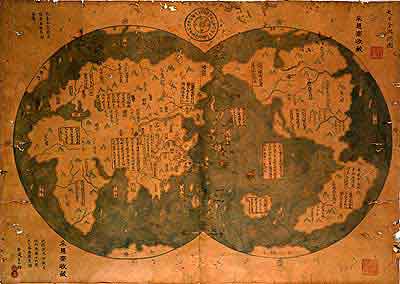

![]()
Zheng He page 2
Remarkable map above clearly shows Australia and New Zealand - attributed to Zheng He.
"Chinese Porcelain and Ceramics
Thousands of pieces of pottery are found washed up on the beaches in Akaroa harbour which would have probably been used by a ship as ballast. Is this pottery from a Chinese Junk? more research needed (Doug Singer)
A reader in New Zealand has found ten clay skulls together in monument form, along with other clay forms (cats, birds, dragons, and buffaloes.) The find was uncovered 3 metres deep in a road slip. The reader believes the finds to be pre-Maori, and there is no history or sign of Maori occupation in the area. Photographs of these objects will be posted on our Gallery soon.
Stone: Buildings/ structures - the Maori did not build in stone.
Palliser Bay Gardens'- stone walls, platforms and alignments extend over miles of coastland from Whatarangi station to Black Rocks, near the lighthouse radiocarbon dated between 1141 to 1608.
Waipoua Forest: 2000 stone piles and structures over an area of 600 acres both sides of the lower Waipoua River (Gary Cook)
A massive stone with a petroglyph plan of gardens which are marked out by a line of low stone cairns
Beautifully paved cobbled road near Brynderwyn, North Island
Le Bon Beach, Banks Peninsula smelter with stonework
Stone wall at Lake Taupo (Kaimanawa) a Chinese observation platform
Drains made for cultivation 50-80ft gully below lagoon on the Kaipara, West coast pre Maori. Drains also found near Kaitaia traversing the swamp lands, also found in North Auckland
Stone settlement in Kaiangaroa Forest. Comprises measured stone walls, possible living quarters. Closed to the public since 1973.
Rock face at Whangape New Zealand appears to have been modified by man 500 years ago (Robert Buchanan) - More research needed
Plants found indigenous to another continent
Maize (Zea Mays) from Peru (Dave Bell)
Scented grass also found in Colombia (Dave Bell)
Marsh cress from America (Navajo Indian cosmetic) discovered by French, 1828 (Dave Bell)
New Zealand Spinach also found in Asia
Taro from China
Kumara from South America no Polynesian DNA has been found in peoples of S. America (Prof. Bryan Sykes) therefore some non-Polynesian people must have charted the islands and carried them over. Acres of pits can be found gravel dug for hilling potatoes 4-5 feet deep
By the time Europeans arrived in NZ the kumara was as thin as a finger, and of little value as a food. The Maori were facing starvation as it was a staple food. This is interesting because it shows no real knowledge of true cultivation and management of plant stock, so the likelihood of them bringing it in canoes and carefully tending it seems more of a myth than ever - Dave Bell
Karaka tree brought over by the Chinese from Easter Island (Journeys into the Mystery Gary Cook)
Conifers appear in Fiji, New Hebrides, Tasmania, Australia and New Zealand:
There are 77 plant species unique to New Zealand, Tasmania and Central America
Chenopodium Album discovered by Cook on South Island, 1769, indigenous to China and North America (Dave Bell)
Paper mulberry (Brouseonetia Papyrifera) from Hawaii used for tapa cloth
Hue (lagenia vulgaris) from Hawaii gourd plant used for food.
Cheilanthes tenufolia from Asia
Wild cabbage (Brassica oleracea)
Broadleaf (Grislinia littoracis) from Chile
Wild turnip from India
Black nightshade from Hawaii
Watercress from California
Miro trees from Pitcairn
Animals found indigenous to another continent
New Zealand has no indigenous animals - Dr Richard Holdaway, fossil researcher
Chinese pigs kune kune
Kaimanawa wild horses (? from Tajikistan); see also Assateague ponies; Brumby horses (Fraser Island); Peruvian Pasos; N. American Bashkir Curlies - more research needed into their origins
Flightless Campbell Island Teal?
Pacific Rat (Kiore) - Dr R.N. Holdaway of Palaecol Research, NZ dates rat bones on NZ to 2000yrs BP during the Han Dynasty - could only have arrived with humans on seafaring craft
Moa - extinct for c.600 years. Primarily believed to be the result of over hunting by the Maori. The work of Dallas Abbott and Ted Byrant (see Part III and Part VIII Appendices) about a comet passing SE Australia and hitting the ocean floor at 48.3º S, 166.4º E creating a tsunami which threw Zhou Man's fleet to South Island. This also resulted in the mass killing many Moa. In order to view a website re the discussion of the distinction of the Moa click here .
Otters - there have been many sightings of the NZ otter. There are no written accounts of Europeans introducing them to NZ. The Chinese carried otters in their Junks to help with fishing.
New Zealand has bats (DNA linked to Peruvian Sea Bats) which are alleged to have "migrated" from South America by being caught in a sea storm off Peru and thus swept to NZ a bit fanciful some might say! Perhaps the Chinese fleets had unwanted passengers? - Louis Hissink M.Sc. M.A.I.G.
Spanish moorhen found on arrival of Europeans. How did this get there? We know that the Chinese had been to Spain - Mulanpi - is this the explanation?
This
Web Directory will always be dynamic ~
all details are flexible and changing